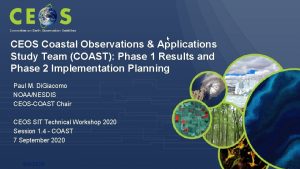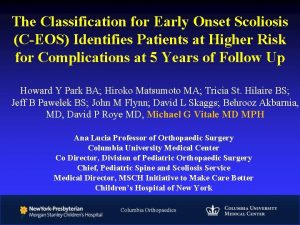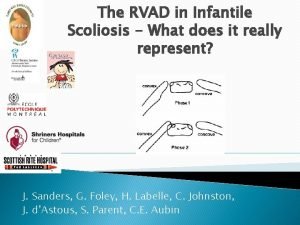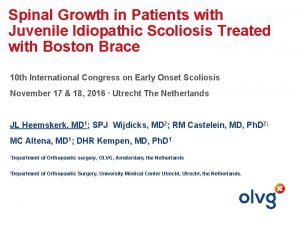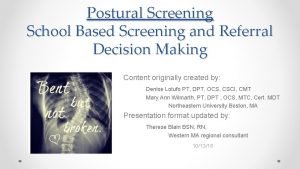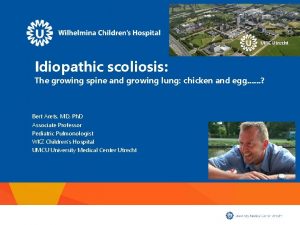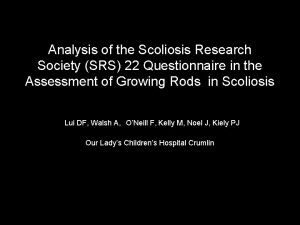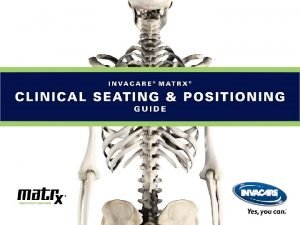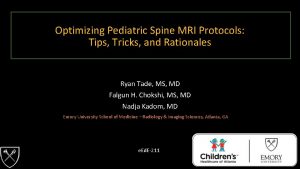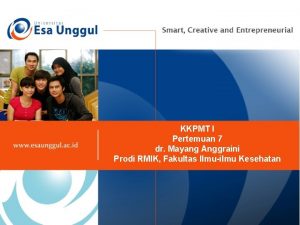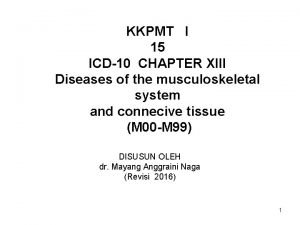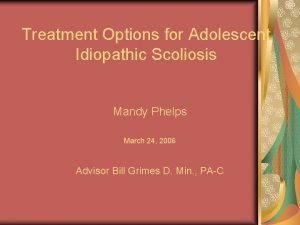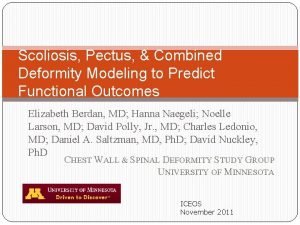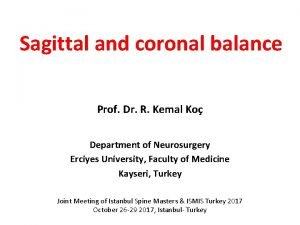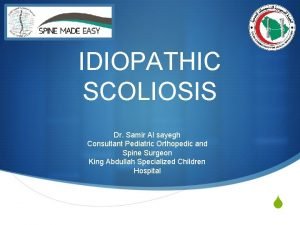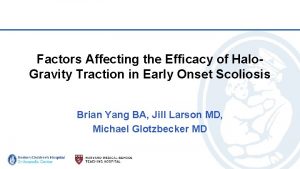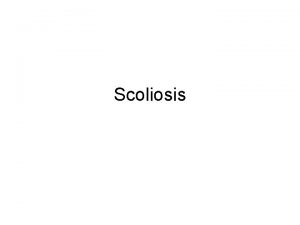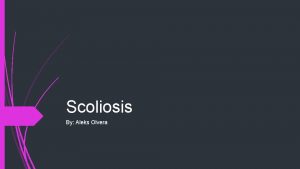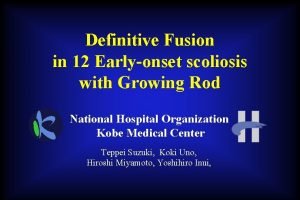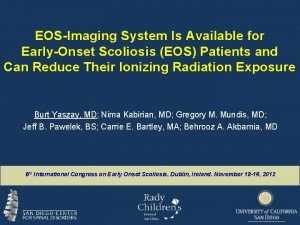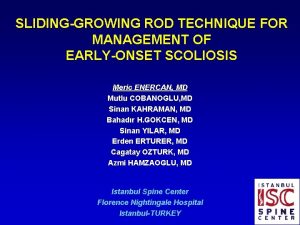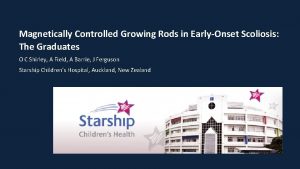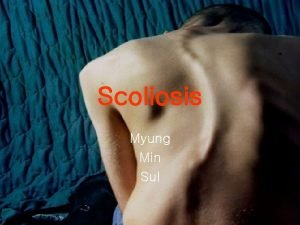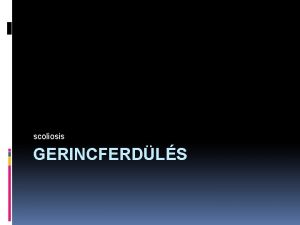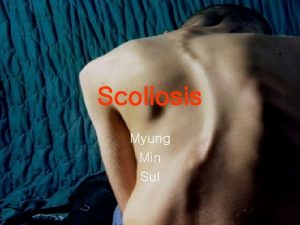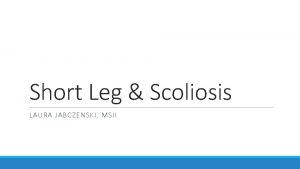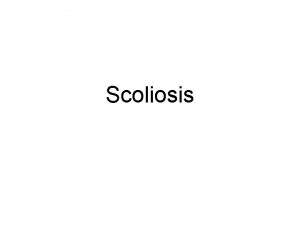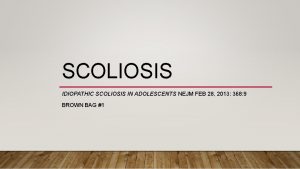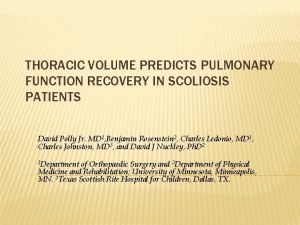The Classification for EarlyOnset Scoliosis CEOS Predicts Timing

















- Slides: 17

The Classification for Early-Onset Scoliosis (C-EOS) Predicts Timing of VEPTR Anchor Failure Michael G. Vitale, MD MPH Associate Chief, Division of Pediatric Orthopaedic Surgery Chief, Pediatric Spine and Scoliosis Service New York – Presbyterian Morgan Stanley Children’s Hospital Ana Lucia Professor of Pediatric Orthopaedic Surgery Columbia University Medical Center

Improving the Evidence Base in EOS Development of a Research Infrastructure Via four parallel efforts Endpoints Development and Validation of a Disease Specific Qo. L Measure Equipoise Evaluating clinical equipoise in the field of EOS Classification Developing an EOS Subgroup Classification Schema to facilitate collaboration and communication Consensus Trial Structure Determining inclusion criteria, treatment options and outcome measures for future research efforts Columbia Orthopaedics

Statement of Purpose To classify EOS patients in order to: • Predict the disease course of individual patients • Prognosticate and determine beneficiaries of differing treatment modalities • Improve communication among EOS providers and facilitate research

Important ‘Philosophical’ Characteristics • Comprehensive: Applicable to all EOS pts • Practical: Utilized in daily practice • Prognostic: Predictive of course • Guide: Informs treatment decisions An Early Onset Scoliosis ‘One Liner’

Methods: Validation Pathway Interviews, Literature Review and Working Session Nominal Group Technique: Iterative Surveying and Group Discussion Reliability Testing Future Work Audige L et al. (2005). A concept for the validation of fracture classifications. J Orthop Trauma. 19: 404 -409 Columbia Orthopaedics

Development of the C-EOS Group Discussion Proposing Variables • POSNA – May 2011 Iterative Survey Assessing Variables • May-July 2011 Validation: Testing the Classification 2011 -Present Group Discussion Finalizing Variables • ICEOS – November 2011

Cobb Angle (Major Curve) Maximum Total Kyphosis Congenital/Structural 1: <20º (-) <20º P 0: <10º/yr Low-tone NM Neuromuscular 2: 21 -50º N: 21 -50º P 1: 10 -20º/ yr (+): >50º P 2: >20º/yr Etiology Highest High-tone NM Lowest Priority Syndromic 3: 51 -90º Idiopathic 4: >90º Etiology (In order of priority): Congenital/Structural: Curves developing due to a structural abnormality/asymmetry of the spine and/or thoracic cavity; includes hemivertebrae, fused ribs, post-thoracotomy, or CDH. §Low-tone neuromuscular: Patients with SMA, spinal injury, Lowtone CP, and muscular dystrophies §High-tone neuromuscular: Patients with spastic CP, Rett Syndrome §Syndromic: Syndromes with known or possible association with scoliosis (including spinal dysraphism) §Idiopathic: No clear causal agent (can include children with a significant co-morbidity that has no defined association with scoliosis) Progression Modifier (optional) Cobb Angle: Measurement of major spinal curve in position of most gravity Maximum measurable Kyphosis: between any 2 levels Annual Progression Ratio Modifier (optional): Progression per year; min. 6 months between observation (Cobb @ t 2) – (Cobb @ t 1) X 12 months [t 2 -t 1]

Applying the C-EOS to Clinical Studies Utilized Dr. Jack Flynn’s (CHOP) data on time to VEPTR Anchor Failure Purpose To assess C-EOS ability to detect differences in time to failure in VEPTR pts

Methods • Retrospective review of VEPTR anchor failure pts • Classified subjects via C-EOS from Dr. Flynn’s VEPTR Anchor Failure Study and analyzed survivorship differences

Data Characteristics by C-EOS Variable N=105 Etiology Cobb Angle Congenital: 56 (53. 3%) 0 -20°: n = 0 Kyphosis*** Neuromuscular: 33 (31. 4%) 21 -50°: n = 17 <50°: 61 Syndromic: 8 (7. 6%) 51 -90°: n = 71 >50°: 26 Idiopathic: 8 (7. 6%) >91°: n = 17 ***Data Limitations - Kyphosis only recorded as < or >50 degrees - Classification necessitates <20, 21 -50, >50 - 18 missing kyphosis

Neuromuscular Pts Exhibit Rapid Failure

Curves >90 Pts Exhibit Rapid Failure

C-EOS Stratified Low Risk and High Risk

C-EOS Stratified Low Risk and High Risk by Classification: Lower Risk of Rapid Failure • Congenital (21 -50° & 51 -90°); C 2, C 3 • Syndromic (21 -50°); S 2 • Idiopathic (51 -90°); I 3 Higher Risk of Rapid Failure • Congenital (>90°); C 4 • Neuromuscular (>51 -90°); N 3 • Neuromuscular (>90°); N 4 • Syndromic (51 -90°); S 3

Conclusions • C-EOS is able to stratify risk of rapid VEPTR anchor failure • Supports validity of C-EOS instrument • Potential for use in clinical setting • Neuromuscular etiology and curves > 90 as individual variables at high risk of rapid anchor failure

Next: 5 Year Out C-EOS Study C-EOS applied to min. 5 Yr follow up pts: • Purpose: Apply C-EOS to identify trends • Methods: – Retrospective review of CWSDSG & GSSG database – Min 5 year follow-up • Endpoints: – Treatment course – Complications per Dr. Smith’s Growing Spine Complications Classification – Change in coronal and sagittal curve over time • Status: Pending data collection from CWSDSG and GSSG Registry

Thank You Michael G. Vitale, MD MPH mgv 1@columbia. edu
 Steve labahn
Steve labahn Ceos coast
Ceos coast Early onset scoliosis classification
Early onset scoliosis classification Rib vertebral angle
Rib vertebral angle Scoliosis chiropractor seminole county
Scoliosis chiropractor seminole county Risser sign
Risser sign Scoliosis
Scoliosis Scoliosis research society
Scoliosis research society Wheelchair backrest for scoliosis
Wheelchair backrest for scoliosis Mri scoliosis protocol
Mri scoliosis protocol Thoracogenic scoliosis of thoracolumbar region
Thoracogenic scoliosis of thoracolumbar region Disorder of synovium and tendon
Disorder of synovium and tendon Infantile scoliosis casting
Infantile scoliosis casting Costodesis
Costodesis Rib hump scoliosis
Rib hump scoliosis Horizontal
Horizontal Dr abdullah sayegh
Dr abdullah sayegh Factors affecting traction
Factors affecting traction

